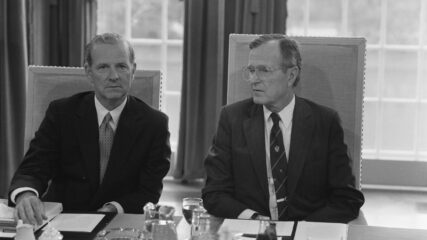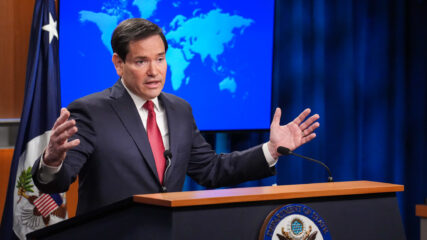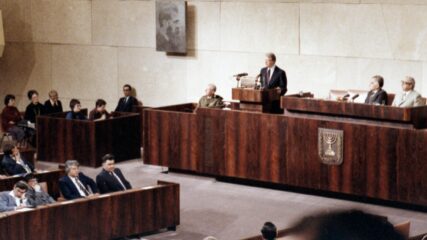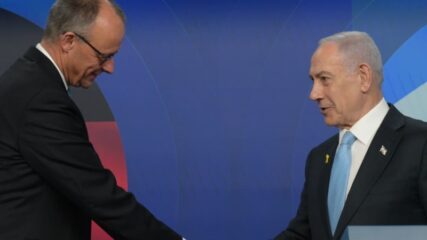Roni Eshel and Ken Stein, 2010
The 1982 War in Lebanon
On June 6, 1982, Israeli military forces entered Southern Lebanon with the intention to carry out a fast operation which would last 48 hours and gain control of 25 miles north of Israel’s border for the purpose of creating a security zone that would prevent terrorist attacks against Israel. The basic objective had gradually expanded and Israel got entangled in a war that lasted three years and it took 18 years for Israel to completely withdraw its forces from Lebanon in the year 2000.
Named Operation Peace for the Galilee by Israel, this war ended up being lengthy, entangled Israel in internationally condemned events, and caused the loss of 1,216 soldiers killed in action between 1982 and 1985.
The war consisted of few phases. The first was the declared intention to end it in 48 hours. The second actually extended the original 48 hours to a military campaign that ended on August 23 when Israeli forces were able to expel the Palestinian terrorists from the Beirut, the Capital city of Lebanon. Then on August 25, 1982, Israel entered Western Beirut, and though it finally retreated from the city to a security zone north of Israel’s border, it remained in that area for many years to come. One significant achievement of the war was Israel’s ability to neutralize the Syrian forces in the area that backed and supported the presence of the terrorists in Lebanon as a whole and more specifically their actions against civilian targets in Northern Israel. Though initially apprehensive about entanglement with the Syrian forces, Israel was successful in defeating the Syrian deployment along the Lebanese border. The Israeli army destroyed the deployment of Syrian missiles along Lebanon’s strategic Baka’a Valley. At the same time Israel gained full control over the Lebanese skies after it downed at the onset 27 Syrian warplanes in a massive air battle and 100 warplanes in total, thus preventing further attacks from the Syrians.
Though the war lasted longer than expected and Israeli casualties were numerous, Israel did not achieve its ultimate objective, which was to reach a peace agreement with Lebanon that would eliminate the constant threat over Israeli civilian targets along the northern border.
Operation Peace for the Galilee was the last in a series of Israel’s attempts to destroy the terrorists’ military infrastructure in Southern Lebanon that was used to launch attacks against the Israel Defense Forces (IDF) and civilian communities. In 1978, Israel launched Operation Litani, an invasion of Southern Lebanon to fight the terrorists up to the Litani River. The IDF withdrew from Southern Lebanon in 1978, but not before forming an alliance with the South Lebanon Army (SLA), thus ensuring the defense of a buffer zone in Southern Lebanon. The buffer zone proved to be ineffective, and terrorist groups from the Palestine Liberation Organization (PLO) continued attacks against Israel and were even able to penetrate into strategic positions in Southern Lebanon, including the slopes of Mount Hermon.
All along Israel backed the SLA and attempted to establish an alliance with the Christian leadership of Lebanon in order achieve political stability in Lebanon that would also result in curbing PLO activities in the area. The relations between Israel and the Christian leadership of Lebanon remained secret and unfolded much later.
All along the PLO became a significant political and military force in Lebanon, creating a state within a state in Southern Lebanon. It also played a key role in the ongoing civil war that marred the political reality of Lebanon. In mid-1981 clashes between Israel and the PLO in Southern Lebanon were constant occurrences. Between July 1981 and June 1982 Israel claimed 270 PLO violations of the cease-fire agreement that the United States negotiated in July 1981. These violations resulted in 29 civilian Israelis killed and more than 300 injured in the towns and villages in Northern Israel.
At the time the PLO military arm in Lebanon numbered 23,000, including 6,000 to 8,000 deployed in terrorist groups in Southern Lebanon.
An event outside the Middle East triggered Israel to step up it actions against the PLO in Lebanon, thus leading to the war that broke out June 6, 1982. Three days earlier, a terrorist faction headed by Ahmed Jibril tried to kill the Israeli Ambassador to Great Britain, Shlomo Argov, in London. Argov survived, but the assassination attempt paralyzed him until his death February 23, 2003.
Israel retaliated on June 4 and 5 against PLO targets in Southern Lebanon, and the PLO responded by launching mortar and artillery attacks on civilian targets in Northern Israel. On June 6, Operation Peace for the Galilee began under the command of Israeli Defense Minister Ariel Sharon. While fighting to gain control over the 25-mile-deep zone in Southern Lebanon, Israel bombarded PLO targets in Beirut and had to fight Syrian forces. Israel deployed massive ground forces while chasing out the terrorists and fighting the Syrians. It also deployed its air force and navy to attack PLO targets in and around Beirut.
By June 14, Beirut was surrounded by Israeli armed forces, which joined with the Christian forces in the city for the purpose of expelling the Palestinian terrorist groups and putting a stop to the Syrian interference in Lebanon internal affairs. Israel besieged and blockaded Beirut from July until August 25, leading to the departure of the PLO forces and their leader, Yasser Arafat, from the city under the supervision of multinational forces. The evacuation was completed in five days. After the departure of the PLO, the leader of the Christian Phalanges, Bashir Gemayel, who was an ally of Israel, was elected President of Lebanon, but on September 14 he was assassinated. After his death, the IDF entered West Beirut, despite an exchange of telephone conversations that U.S. President Ronald Reagan held with Menachem Begin to thwart Israel from making such move. Begin moved on regardless of the plea of Reagan and a previous agreement with the American special emissary Philip Habib.
Israeli command in West Beirut had made an agreement with the Christian Phalanges that they would be permitted to deal with terrorists who had not departed with Arafat. The Phalanges were supposed to search for those terrorists in areas that were concentrated with Palestinians. On the evening of September 16, they entered the Palestinian camps in Sabra and Shatila, and shortly thereafter they began to kill camp residents indiscriminately. Upon the demand of the IDF, they left the camps in the morning hours of September 18. This mission turned out to be fatal, with lasting impact on Israel, its military and political leaders, and the general public. The approximately 150 Phalanges who undertook the mission full of rage sought revenge for the assassination of their leader. They massacred 700 to 800 children, women and elderly Palestinians in the camps.
Bits of information about the massacre started to emerge September 17 when Israeli soldiers around the camps noticed some irregular activities, though that they were not aware of their nature and scope. It was reported that Begin heard about the massacre only at 5 p.m. September 18 while listening to news on BBC radio.
The IDF may have had warning intelligence about the intentions of the Phalanges but did nothing to prevent the massacre.
Though the massacre was executed by the Christian Phalanges, Israel was perceived as being involved because the IDF controlled the area and let the Phalanges enter the camps.
Worldwide condemnation of Israel followed, and Israel was asked to evacuate Lebanon immediately. American Marines and French soldiers were sent to the area to restore order. On December 16, 1982, well after Israel decided to investigate the affair and before it published its conclusions, the U.N. General Assembly condemned the events in the refugee camps in Resolution 37/123 on a 123-0 vote, with 22 abstentions and 12 countries not voting. Section D of the resolution defined the “massacre as an act of genocide.”
After the massacre, Begin and the Israeli government became subjected to intense internal criticism as well. The Israeli Shalom Achshav (Peace Now) movement organized a massive demonstration in Tel Aviv on September 25, 1982. This gathering, which became known as the 400,000 Demonstration, heard calls for the resignations of Begin and Sharon and an investigation of the events that occurred in Sabra and Shatila. Until that point Begin supported a check of those events but not under the magnifying glass of a national inquiry commission. However, three days after the demonstration and with increased public and political pressure, the Israeli Cabinet resolved to establish a commission of inquiry in accordance with the Commission of Inquiry Law of 1968. The Cabinet asked the commission to investigate “all facts and factors connected with atrocity carried out by a unit of the Lebanese Forces against the civilian population in the Shatila and Sabra camps.”
The commission, which became known as the Kahan Commission and was formally the Commission of Inquiry into the Events at the Refugee Camps in Beirut, was headed by Israeli Supreme Court President Yitzhak Kahan and had two additional members: Supreme Court Judge Aharon Barak and Maj. Gen. (res.), Yonah Efrat.
Commission Findings
For four months, the Kahan Commission investigated the events surrounding the massacre. Fifty-eight people were summoned to testify before the commission, and scores of other testimonies were collected. The commission produced a 149-page report that included a classified addendum. On February 8, 1983, the Kahan Commission made the report public with its recommendations and conclusions. Its basic premise was that Israel had no direct responsibility for the events and that the main party responsible for the massacre was the Christian Phalangists who entered the camp and carried out the atrocities. The commission stated, though, that Israel had to be held indirectly responsible. It also concluded that Israel had no intention for the civilian population to be endangered and hurt. Still, the commission found some faults and misjudgments among political and military leaders. The recommendations had a major impact not only on the leaders of the government, but on the highest-ranking commanders of the IDF.
The commission refrained from making personal recommendations about Begin or determining whether he was directly responsible for the events. Nevertheless, its conclusion put some public burden of responsibility on his shoulders.
The commission recommended sanctions against Sharon, the highest-ranking political figure to face such a finding. The Commission concluded that he had personal responsibility because he ignored the danger of bloodshed and revenge from allowing the Phalanges to enter the camps, and he did not take the proper actions to protect the civilian inhabitants of Beirut from the possibility of massacre after the city came under Israeli control. The commission recommended that, if necessary, the Prime Minister should use his authority to remove Sharon from his post as Defense Minister. Despite these recommendations, Sharon refused to resign, and Begin was hesitant to remove him.
Once again, the public protested and held numerous demonstrations. Sharon resigned but remained in the Cabinet as a minister without portfolio. Though his public image was tarnished, Sharon survived politically and later became the Prime Minister.
With regards to the IDF Chief of Staff, Lt. Gen. Rafael Eitan, the commission determined that he did not take the proper actions to prevent the danger of a massacre and even afterward did not try to stop the massacre. By not doing so he did not fulfill his duties as the Chief of Staff. The commission did not recommend removing him from his post because his tenure was about to come to an end.
The commission found that the commander of the IDF Intelligence Branch, Maj. Gen. Yehoshua Saguy, was guilty of apathy and ignored the potential danger of the Phalanges’ actions. The commission also found that he failed to fulfill his duty by not conveying the proper warnings to the decision-makers. The commission recommended that he should be removed from his post, and he promptly resigned from his military service. The commission also reprimanded Foreign Minister Yitzhak Shamir for not acting upon information that was given to him by Communication Minister Mordechai Zipori, a former high-ranking IDF officer who during the war was one of the few who confronted Sharon about the course of the war and his decisions. The commission noted that one minister ignoring the information given to him by a colleague represented a worrying sign about the performance of that government. Even the head of the Mossad, Yitzhak Hofi, received the commission’s criticism. The commission said he should have taken into account the likelihood of acts of revenge for the assassination of Gemayel, “but his direct responsibility is minimal.”
As a result of the commission’s recommendations, the commander of the IDF forces in Lebanon, Amos Yaron, was removed from any command post in the IDF for three years. The commander of the IDF Northern Front, Amir Drori, was reprimanded for not taking any actions in anticipation of the Phalanges’ mission, but he completed his duty and in September 1986 was promoted to IDF Deputy Chief of Staff.
The commission concluded its report by noting: “We have striven and have spared no effort to arrive at the truth, and we hope that all persons of good will who shall examine this issue without prejudice will be convinced that the inquiry was conducted without any bias.”
Operation Peace for the Galilee failed to achieve its overall targets, and the country experienced for the first time a lack of national consensus. Never before were any of Israel’s wars publicly debated and vehemently objected to. Begin defined the operation as a war of choice.
A new government was formed in 1984, and a lengthy withdrawal of the IDF from Lebanon began. This process was completed on May 24, 2000, when the last of the Israeli soldiers departed from Southern Lebanon after 18 years.
Begin, the statesman who brought peace with Egypt, ended his public life and political career when he announced September 15, 1983: “I can no longer.” A few weeks later he submitted his resignation to the president. He spent the rest of his life in reclusive retirement until his death March 9, 1992.
Kahan Commission Sources
Report of the Commission of Inquiry Into the Events at the Refugee Camps in Beirut, 81 pages, February 8, 1983, https://www.gov.il/en/pages/104-report-of-the-commission-of-inquiry-into-the-events-at-the-refugee-camps-in-beirut-8-february-1983.
June 6, 1982, exchange of letters between Reagan and Begin: https://www,jewishvirtuallibrary.org/prime-minister-begin-exchange-of-letters-with-u-s-president-reagan-june-1982.
The Lebanon War (1982) Lexicon in http://www.ynet.news.com
The Lebanon War: Operation Peace for Galilee: https://www.gov.il/en/pages/lebanon-war-operation-peace-for-galilee.
John H. Kelly, Lebanon: 1982-1984 in http://www.rand.org/pubs/conf_proceedings/CF129/CF-129.chapter6.html
First Lebanon War 1982-1985 in http://www.jewishsearch.com
Amir Oren, 1982 memo shows Israel learned little from first Lebanon War,
Ha’aretz December, 7, 2009
Weintraub, Bernard, Reagan Demands to end to attacks in a blunt telephone call to Begin, The New York times, August 13, 1982
The Massacre in Sabra and Shatila, in ynet.co.il








